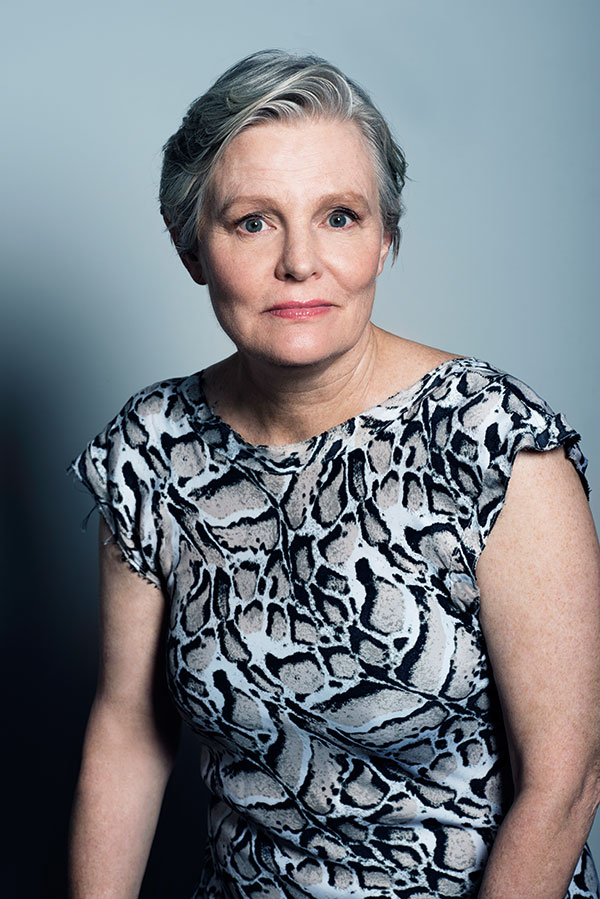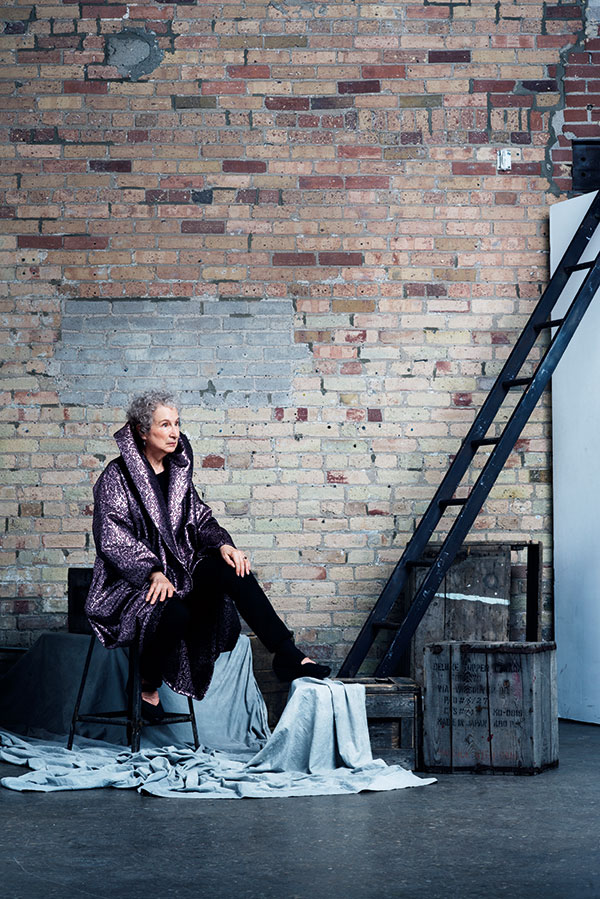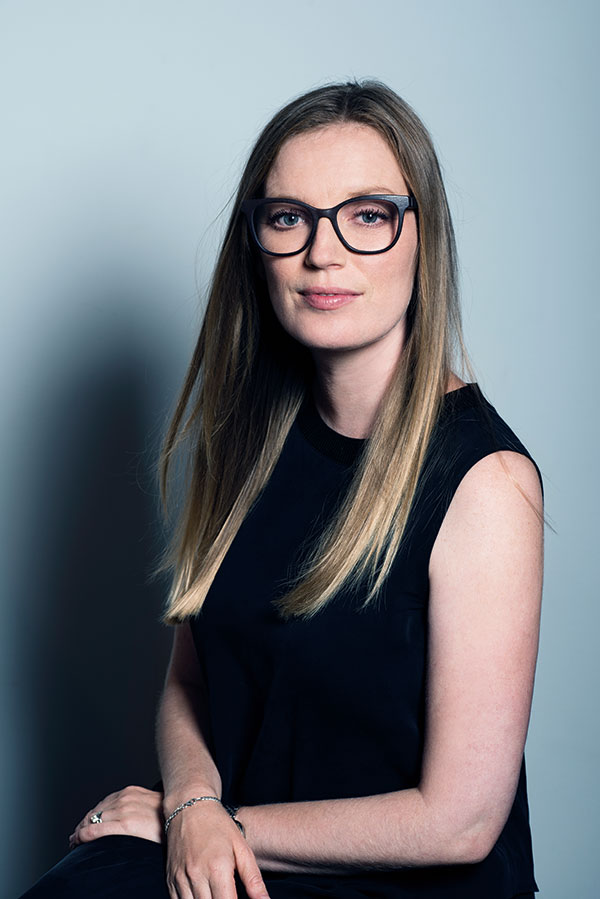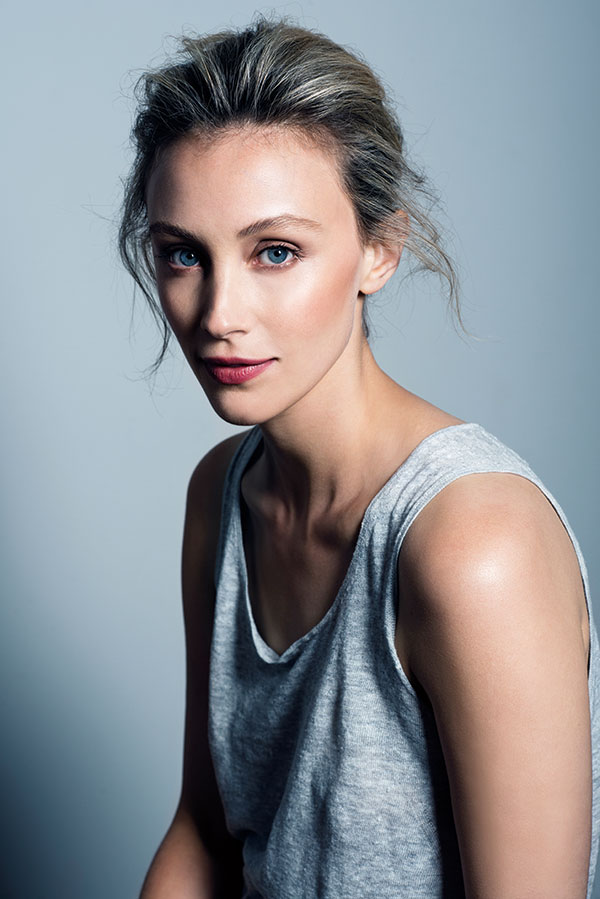Meet The All-Female Team That Brought ‘Alias Grace’ to the Screen

Left to right: Mary Harron, Sarah Gadon, Margaret Atwood, Sarah Polley. Photo: Caitlin Cronenberg
As a blockbuster production of Alias Grace reexamines a historic crime with gender politics at its root, Johanna Schneller meets with the powerhouse all-female team that brought the novel to the screen.
It was Day 1 on the set of the six-part television series Alias Grace, based on Margaret Atwood’s award-winning 1996 novel, which itself was based on the true story of Grace Marks, an Irish immigrant to Upper Canada who was convicted for a notorious 1843 double murder. (Whether she committed the murder, abetted it or was innocent is still unknown; the shifting nature of “truth,” filtered through the sexism of the era, is the story’s real subject.) Sarah Polley had written all six hours of the screenplay, and Mary Harron (American Psycho) was directing them. Atwood herself was there to do a cameo, as a neighbour scandalised that Thomas Kinnear (Paul Gross), a wealthy unmarried landowner, was flaunting his lover, Nancy (Anna Paquin), and their new housekeeper, Grace (Sarah Gadon), in church. (Grace gets pulled into the drama, and things end badly for all three. It’s a Margaret Atwood story.)
Atwood had a character name: Disapproving Woman. She had a trailer with that name on its door. She had a costume – drawers, camisole, corset, petticoats, overskirt, jacket, capelet, shawl, bonnet and boots – and two dressers to rope her into it. Disapproving Woman sits in a pew; viewers see little of her costume. But they wanted her to feel authentic.
Her scene was supposed to be shot in daylight, but first days are tricky, and the hot August afternoon dragged into evening. A searchlight was aimed through the set’s windows to evoke morning. “I was frying,” Atwood recalls now, sipping a green smoothie on a restaurant patio near her Toronto home. Small grin. “No wonder I looked disapproving.”
But when the cameras rolled, Atwood got into the spirit. Way in. “She gave herself a line,” Polley recalls, with a grin of her own.
The script supervisor asked if Atwood’s improv – “It’s disgraceful. Disgraceful!” – was okay. “I would think it would be,” Polley replied. The sound person hurriedly tucked a microphone under Disapproving Woman’s capelet. When the episodes air on CBC and Netflix this fall, Atwood’s line will be there, delivered with enough vehemence to make her signature gray curls shake.
At age 77, with 16 novels, eight short fiction collections, 17 poetry collections, eight children’s books, 10 non-fiction books, three television scripts, two opera libretti, one graphic novel, 24 honorary degrees (including Oxford, Harvard and the Sorbonne) and at least 25 major awards to her name (including a Giller Prize, Booker prize and the Companion of the Order of Canada), the Ottawa-born Atwood is hotter than ever. Last April, The New Yorker published a laudatory profile, timed to the release of the television series based on Atwood’s 1985 novel The Handmaid’s Tale – about a dystopian near-future in which the U.S. is a theocracy, and women are brutally suppressed into being wives, servants or breeders (handmaids). In July, that series was nominated for a whopping 13 Emmy Awards, including Outstanding Dramatic Series and Lead Actress for Elisabeth Moss, who plays the handmaid Offred.
As of mid-July, The Handmaid’s Tale novel was near the top of the New York Times bestseller list for its 14th week – 32 years after its publication. Affectionate parodies pepper the internet, such as the one on Funny or Die, called “Finally, a Handmaid’s Tale for Men.” (“I used to be CEO of a large corporation,” a man intones darkly. “Now I’m CEO of a large corporation but with some female colleagues.”) And ordinary women are donning the handmaids’ striking red gowns and white bonnets and staging peaceful sit-ins in state legislatures across the U.S., to protest the Trump administration’s cuts to women’s health care.
Atwood had a cameo in The Handmaid’s Tale, too, as a handmaid trainer who slaps Offred’s face. “I’m getting typecast,” she says, deadpan. Oh, how to describe Atwood’s voice? Deep, nasal and meticulously enunciated, it sounds flat at first. But quickly you tune in to how her smallest inflection bends serious into mischievous, or wry into mirthful.
“I’m having a moment,” she continues. “Who would have predicted that?” Ask if there’s a reason, and she emits a small explosion. “Of course there’s a reason! Trump got elected. He’s a symptom of stuff that was already going on, even more in recent years than in 1985. Back then, some critics could say, ‘This is absurd. It could never happen.’ Nobody is saying that now.”
Alias Grace is similarly timely. It’s a true-crime story with an ambiguous ending, in the vein of the podcast Serial or the miniseries The People vs. O.J. Simpson. It’s a meditation on the shifting nature of truth, perfect for this era of fake news and alternative facts. It’s an immigration story, about a maligned group struggling to survive in a new country. It’s about sexism, how women aren’t considered reliable narrators of their own stories.
And it’s an unflinching, feminist-minded deep dive into an undertold chapter in Canada’s colonial history, when lower-class serving women such as Grace were deployed like cannon fodder to satisfy the sexual needs of their upper-class masters, so they could preserve the sanctity of the women they married. Women like Grace were routinely physically and sexually abused; if they got pregnant, they took drastic measures or were cast into the streets. So viscerally does Harron depict the aftermath of a back-alley abortion – a practice which the Trump administration seems determined to revive – that Atwood had nightmares after seeing the episode, even though she’d had none while writing the book.

“What’s exciting for me about [the series] The Handmaid’s Tale and Alias Grace coming out in the same year,” Polley says, “Handmaid’s Tale offers us a peek into the future of what life could look like for women, and Alias Grace gives us a look into the past, of what life did look like. It puts our particular place, where we have rights and freedoms we take for granted, into context as a very small blip in history. One that can easily be eroded. It’s a window we have to keep open with all of our force.”
“Last Nov. 9,” Atwood agrees – the day after Donald Trump’s U.S. presidential victory – “both The Handmaid’s Tale and Alias Grace morphed into different shows. Not because the productions had changed but because they were framed differently. Everyone understands that. But it’s nothing to do with me. I was just sitting there.”
Atwood has spent little of her life “just sitting” anywhere; she’s always cooking up something. As a graduate student at Harvard in the 1960s, she studied 19th-century American literature. She was deep in the underground stacks at the Widener Library (“These were the days when, as a woman, you couldn’t get into the poetry library,” she says), poking around the Witchcraft section, when she stumbled on a stack of Canadian books someone had stashed away. (“That person must have died because it cut off abruptly,” she says with some glee.) Among them was Susanna Moodie’s Life in the Clearings, which contains Moodie’s version of Grace Marks’ story.
Atwood read the book, then had a dream in which she’d written an opera with only one character: Moodie. “When you read her, you have this gentlewomanly voice going along the top, and underneath you have this rage that she’s not quite expressing,” Atwood says. (The same can be said for Grace.) She wrote the poetry that became 1970’s The Journals of Susanna Moodie, followed by a TV play about Grace Marks. Then, in Zurich in 1982 – “home of Carl Jung,” Atwood says, arching an eyebrow – a piece of writing flowed out of her onto hotel notepaper decorated with swans. “It was the first chapter of Alias Grace, much as you have it,” she says. “I thought, ‘Grace Marks wants me to take another look at this.'” Thank you, whoever amassed those books in Widener.
Next: Day 58 on set…

Day 58 (of 65) on the Alias Grace set. Atwood isn’t here today but her presence hovers. Every member of the crew mentions how they hope to do justice to her.
Polley stands near the monitors, squeezing a piece of pink Play-Doh (a pizza slice made by one of her two young daughters, who’d instructed her to bring it to set and “show everybody”). “The highlight for me, and a lot of us in our careers,” Polley says, “was showing Margaret Atwood the sets of her novel, walking her through the spaces she’d written, showing her the objects, like the head-measuring device we borrowed from a museum [used on Grace], which she’d never seen before. It was the most extraordinary, surreal experience.”
The series’ excecutive producer, Noreen Halpern, points out the wallpaper in the servant’s bedroom (of good quality but ripped and stained with age) and the grooves in a staircase (to suggest wear). In a novel, you can write, “She got on a train.” In a film, you have to know which train. The preserves in the murder cellar were made as they were in the 1830s: topped with a piece of wet pigskin tied with string, which would seal as it dried. Even Atwood hadn’t known that. (“It says botulism to me,” she says juicily.)
Halpern walks by another set, the hold of the ship on which the Marks family sailed from Belfast to Canada. It rests on a machine that pitched and rocked it to create the terror of a storm at sea. Thousands of gallons of water were pumped through it, along with 16 rats, under the direction of a professional rat handler.
Polley made sure she was on set that day. It was the scene she’d fought hardest to keep. “One of the most pressing issues in the series is about immigration, class,” she says. “We look at refugees and immigrants now, and we forget the squalor and horror they went through to get here. There’s always a stigma. So that was my line in the sand: this is what we need to see right now.”
She brought her children to watch, too. “Mostly they just played with the rats,” Polley says. “My two-year-old told me, ‘I love your work!'”
Tonight, all eyes are on the governor’s study, an elegant set in which Grace relates her story to a doctor, Simon Jordan (Edward Holcroft), who wants to exonerate her. Shot over six intense days, then cut through with flashbacks, this 70-page conversation forms the series’ spine. It looks like a Vermeer painting, but the period dialogue is a mouthful, and Gadon has to perform it while sewing quilt patches.
“If we were all on trial for our thoughts, we’d all be hanged,” Gadon/Grace says.
“Could you do one that’s slightly guiltier?” Harron asks. Gadon does.
“And now one where you might be remembering something?” Harron asks. Gadon does.
To make things even tougher, the studio is on an airport flight path, so every five minutes a plane’s roar interrupts the action. “Sarah will have a tear quivering on her eyelid, and we’ll have to hold for the plane,” Halpern says. “Mary will say, ‘Hold that tear.’ And Sarah can.”
“If I were her, I’d be crying by now for real,” Polley says.
Harron asks Polley if Grace should touch Simon’s hand. “All I can think is, ‘What would Margaret Atwood say?'” Polley replies. “I think about that a lot.” She imagines Atwood’s answer would be, “It’s not very Victorian.” Simon’s hand remains untouched.
Polley, 38, has had Atwood’s voice in her head since she was 17, when her agent handed her a copy of Alias Grace and suggested she option it. “I got lost in it,” Polley says now. It’s June, a few days after she, as executive producer, helped lock the final edit of Alias Grace. She’s in a Mexican restaurant in Toronto, eating chips and guacamole. “It raised questions for me, questions I’ve made work about in the 20 years since. About memory, versions of stories, what it means to forget, what happens to rage, who are the many people we are, what narrative does to us.” (Her award-winning semi-autobiographical documentary, Stories We Tell, which uses a similarly layered approach to truth, was inspired by Alias Grace.)
Not surprisingly, Atwood’s agent didn’t think a 17-year-old was ready to option it. Over the next 20 years, however, as the rights bounced from company to company, Polley became a successful writer-director. At 30, she checked on the book’s status and discovered that the rights had become available two weeks earlier. “It was the most amazing angel choir singing moment,” she says. She snapped them up.
Before writing a word, though, Polley met with Atwood. She needed to know what mattered most to her about Grace’s story. Atwood’s answer: its ambiguity. “I’d looked at every piece of evidence, and there is no one answer,” Atwood says now. “It’s like those optical illusions: look at it one way and it’s a bird, another way it’s a staircase.”
For a year, Polley typed in snatches during her toddler’s naps. Then she got pregnant again. “Which meant Margaret, who had this very hot property, had to wait another two years,” Polley says. “But instead of being pissed, she was sending me flowers in the hospital, picking up little dresses for my daughters in Mexico and talking about motherhood with me. That boggled me. Everyone talks about how honest Atwood is and bold and clear and sometimes hard. But I find her to be extremely nurturing and maternal. I kept expecting her to get angry about how long I was taking, and all I got was, ‘You asked for the rights years ago, and I had to say no. Now I’ve said yes. If it means waiting, it’s still yes.'”
Polley’s finished script ran 700 pages long. But if she cut it down to feature length, she’d lose everything she loved about it. She booked a coffee with Atwood. She didn’t sleep for a week beforehand. But the minute she opened her mouth, Atwood finished her sentence. “‘Should it be a six-part miniseries? Yes,'” Polley recalls, in pitch-perfect Atwood-ese.
Next, Polley recruited Halpern. The producer had loved Atwood “since I started reading.” She read all six scripts in one sitting. Her first thought: “I love this.” Her second: “We’re going to have to raise a massive amount of money.” Polley agreed: if they couldn’t get US$30 million, they shouldn’t do it at all. “I was only able to insist because I was still slightly afraid of Margaret,” Polley says, laughing.
Next: The director…

Next step: a director. Usually when she wrote a script, Polley could see every shot. Halfway through Alias Grace, she realized she couldn’t – the ambition was too sweeping, the tone too raw. She thought immediately of Mary Harron. “She has an intense, dark sensibility that’s closer to Atwood’s than mine is,” Polley says. “I loved the novel too much to not put it in the right hands.”
And frankly, the book was driving Polley a bit mad. “It spoke to a duality I have in me that I find disturbing,” Polley admits. “The sense of being one person but also carrying a lot of things you haven’t addressed. What happens to that anger or damage when it’s not allowed to be expressed? There’s that Emily Dickinson quote, ‘ourself within ourself concealed.’ Who are we that we haven’t discovered yet? I thought, ‘It’s too close to something dangerous for me.'”
Gadon understands that. “When you’re a young actor, identities are projected onto you,” she says. “That happened to Grace – at a young age, other people took control of her identity. I connect with that. I wouldn’t be surprised if Sarah Polley did, too.”
Harron signed on immediately – she’d read English literature at Oxford so was steeped in the form that Atwood and Polley were reworking. “I saw Alias Grace as a Victorian novel but with all the censored bits left in,” Harron says over a plate of deep-red beef carpaccio at a Toronto restaurant.
“It’s more than just a drama. It’s an important piece of hidden history. People don’t know what these girls went through. It’s been sanitized.”
The CBC also signed on: “There’s something timeless and timely about Grace,” says programming chief Sally Catto. “People project onto her what they want to see, based on their own biases,” which makes her perfect for this political moment. “It’s historical yet progressive at the same time.”
There remained the small matter of the $30 million. Polley, Harron and Halpern headed to L.A., where they pitched eight co-production entities in three days. Most of the executives were women. Three made bids. Netflix won. (Netflix and CBC also partnered on the series Anne.) Thanks to their cash, “We were able to film this Canadian book, written by and starring Canadians, in the province where the events took place,” Harron says.
The next hurdle: casting Grace. Before Polley secured the rights, Kiera Knightley and Cate Blanchett had flirted with the role. Polley and Harron’s first choice was Sarah Gadon, 30. Her star was ascending, from Belle and Maps to the Stars through Indignation and 11/22/63. But even she had to audition three times to prove she could play Grace from ages 15 to 40.
Before filming, Gadon sat in her garden and read the script aloud to Harron to delineate different versions of Grace: good Grace, bad Grace, neutral Grace. Gadon also attended “period boot camp” at Pioneer Village, where she learned to sew, quilt and milk cows. To prepare for a key hypnotism scene, Gadon’s father, a psychologist, hypnotized her, and her mother filmed it, so Gadon could see what a trance was like and how she looked while in one.
Now, sitting over drip brew in her neighbourhood coffee shop, she recalls how overwhelming it felt: the Belfast accent, which at one point locked her jaw. Working with her hero, Polley, on a project that was so important to her. “When I was first acting,” Gadon says, “Sarah was the only actress I knew of who worked internationally with incredible directors in studio films yet lived in Toronto. She gave me the glimmer of possibility that I could have that, too.”
And, of course, there was Atwood. “She’s an icon of mine,” Gadon says. “I grew up reading her books in school. And she’s tough. She doesn’t mince words. I wanted so desperately for both her and Sarah to approve of me. I’d get so ridden with anxiety that I’d have to just go run. Even talking about it now, I’m going to break into a run.” She laughs. “Bye!”
Next: The physical demands…

During the shoot, Gadon stopped sleeping at night. She’d never experienced that on a job before. The physical demands were extreme. She was in nearly every scene. She had to do three versions of Grace for every take. She was doing period housework, carrying heavy buckets, scrubbing floors.
“On camera, you see me actually aging as if I’d been in prison for 15 years,” she chortles. But she also realized, “What a gift. Will I ever be challenged that much creatively again?”
Through it all, Gadon felt the presence of so many women behind the camera, especially during scenes of violence or sexual assault. “There were so many times we’d be blocking a scene, and Mary would remind everyone, ‘No, it has to be from Grace’s perspective,'” Gadon says. “Deciding where to put the camera has such an impact. That becomes the gendered lens we all talk about.
“Not that a man can’t tell a beautiful story about a woman,” she continues. But Grace Marks was such an object of desire and fascination, and her story was “claimed by so many men.” A group of women reclaiming her story felt important.
When Polley first read Alias Grace, she was the age Grace is at the beginning. Now she’s almost the age Grace is at the end. “I’ve put more hours of work into this than I’ll put into writing anything,” she says. She did that because she genuinely believes that “film and television can look back on history and give a voice to a group that was previously squashed or silenced.” That’s the work she wants to keep doing.
“I spent my childhood on CBC in this bucolic vision of this time that never existed in this country,” Road to Avonlea, she continues. “So to be back on CBC in this brutally honest look at what it was actually like for women, and people get spattered in blood, was extremely cathartic.”
As of this writing, Atwood has seen most of The Handmaid’s Tale and much of Alias Grace. She’s thrilled with both. Not because she needs more awards: “Thank you very much, they’re lovely, but I actually don’t,” she says. Not because they burnish her fame. “I’ve always been the Wicked Witch to some people. And Glinda the Good to others,” she says. “Status waxes and wanes. It’s very nice when you’re having a moment. People think you’re important. But there will come another moment when they don’t.”
Atwood is pleased with these television adaptations because they take seriously what she takes seriously. “I believe in fostering writing and reading as a very important part of democracy,” she says. “Maybe I was improperly socialized, but there are quite a few things I don’t give a shit about. I’m not a politician. I’m not running for office. I don’t have a job. The only way to fire me is to ban all my books. Or stand me up against a wall and shoot me. That’s been done a lot. That’s why I support PEN Canada and Canadian Journalists for Free Expression. And why I think there should be a memorial to murdered journalists in High Park. Why were they killed? Trying to get the story for you. I do give a shit about that.”
It’s been 150 years since Grace was finally freed from prison. But Atwood and Polley know that women still suffer as she did. “We’ve seen it a lot this year: When you’re a victim of sexual violence, you are silenced, ridiculed,” Polley says. “It’s still not a safe world to come forward. Our anger and rage have had to be tamped down. We’re not comfortable with women expressing that.

“We’re not even comfortable with women being clear,” Polley continues, heating up. “When I first became a director, I managed it by playing a grateful baby girl. On my second film, I didn’t do that anymore. I just told people what I wanted in the clearest way I could.” She wasn’t being aggressive – she’d seen enough aggressive directors to know the difference. “Still, I got a lot of comments from men: ‘Whoa, you’ve changed a lot. You’re really confident.’ And they didn’t say it as a compliment.”
Gadon, too, knows how pertinent Grace’s story still is. Recently, she was on a Toronto-New York flight that was grounded on the tarmac. Four men in their mid-20s sitting behind her began to complain aggressively to the flight attendant. The attendant offered to de-plane them. They demurred. But as she walked away, one of them loudly said, “Bitch.” A second later, they were dropping the c-word, feeling fully entitled to. The insults continued for two hours.
Everyone in Gadon’s row squirmed. No one spoke up, including Gadon. Their aggression silenced her. “This accepted level of sexism – I haven’t been able to stop thinking about it,” Gadon says. “It’s so important that we tell stories like Grace’s and really look at our ingrained, systemic, accepted inequality.” She pauses. “It was such an awful moment,” she says, “when we landed at LaGuardia, and those men just walked away.”
That’s the kind of moment Atwood, Alias Grace and all the women behind it want us to look at, to think about and never to forget.
A version of this article appeared in the October 2017 issue with the headline, “A Woman’s Tale,” p. 41-49.
RELATED:
10 Zoomer Magazine Covers That Feature Pioneering Women
Historic Wins and Heartfelt Comeback Stories Highlight the 95th Academy Awards